Stochastic Differential Equations, Sixth Edition
Solution of Exercise Problems
Yan Zeng
July 16, 2006
This is a solution manual for the SDE book by Øksendal, Stochastic Differential Equations, Sixth Edition.
It is complementary to the books own solution, and can be downloaded at www.math.fsu.edu/˜zeng. If you
have any comments or find any typos/errors, please email me at yz44@cornell.edu.
This version omits the problems from the chapters on applications, namely, Chapter 6, 10, 11 and 12. I
hope I will find time at some point to work out these problems.
∞
k=0
∞
k=0
1
k!
(− t
2
)ku2k.
ik
k! E[Bk
t ]uk =
E[eiuBt] =
E[B2k
t
] =
1
k!(− t
2)k
(−1)k
(2k)!
=
(2k)!
k! · 2k tk.
Ex[|Bt − Bs|4] =
Ex[(B(i)
t − B(i)
s )2(B(j)
t − B(j)
s )2]
· (t − s)2 + n(n − 1)(t − s)2
s )4] +
i=j
t − B(i)
Ex[(B(i)
n
= n · 4!
2! · 4
= n(n + 2)(t − s)2.
i=1
2.8. b)
Proof.
So
d)
Proof.
2.11.
Proof. Prove that the increments are independent and stationary, with Gaussian distribution. Note for
Gaussian random variables, uncorrelatedness=independence.
2.15.
Proof. Since Bt − Bs ⊥ Fs := σ(Bu : u ≤ s), U(Bt − Bs) ⊥ Fs. Note U(Bt − Bs) d= N(0, t − s).
3.2.
1
�
Proof. WLOG, we assume t = 1, then
(B3
j/n − B3
(j−1)/n)
B3
1 =
=
=
j=1
n
n
n
n
j=1
j=1
+
j=1
:= I + II + III
n
[(Bj/n − B(j−1)/n)3 + 3B(j−1)/nBj/n(Bj/n − B(j−1)/n)]
(Bj/n − B(j−1)/n)3 +
3B2
(j−1)/n(Bj/n − B(j−1)/n)
j=1
3B(j−1)/n(Bj/n − B(j−1)/n)2
By Problem EP1-1 and the continuity of Brownian motion.
I ≤ [
To argue II → 3 1
n
0 B2
j=1 B2
(j−1)/n1{(j−1)/n
By looking at a subsequence, we only need to prove the L2-convergence. Indeed,
2
E
E
j=1
n
n
n
n
n
j=1
j=1
j=1
j=1
=
=
=
=
B(j−1)/n[(Bj/n − B(j−1)/n)2 − 1
n
]
(j−1)/n[(Bj/n − B(j−1)/n)2 − 1
B2
(Bj/n − B(j−1)/n)4 − 2
E
n
]2
j − 1
n
j − 1
1
n2 − 2
n
2(j − 1)
n3 → 0
(3
1
n2 +
1
n2 )
(Bj/n − B(j−1)/n)2 +
n
1
n2
(Btj+1 − Btj )
(Btj+1 − B tj +tj+1
2
) + Btj (B tj +tj+1
2
− Btj )
+
j
(B tj +tj+1
2
− Btj )2.
0 BtdBt. For the second term, we note
as n → ∞. This completes our proof.
3.9.
2
2
j
j
B tj +tj+1
B tj +tj+1
The first term converges in L2(P ) to T
Proof. We first note that
=
=
=
tj+1 − tj
=
B tj +tj+1
B tj +tj+1
B tj +tj+1
= E
tj+1−tj
2 ·
B2
j, k
E
E
E
j
j
j
2
2
2
2
2
− Btj
− Btj
2
2
2 − t
2 −
2 − tj+1 − tj
2
2
j
tj+1 − tj
2
2
− Btj
− tj+1 − tj
2
2
2 − tk+1 − tk
2
− Btk
B tk+tk+1
2
since E[(B2
j
≤ T
2
max
1≤j≤n
t − t)2] = E[B4
|tj+1 − tj| → 0,
t − 2tB2
t + t2] = 3E[B2
(Btj+1 − Btj ) →
T
t ]2 − 2t2 + t2 = 2t2. So
1
2 B2
BtdBt + T
2
=
T
0
B tj +tj+1
2
j
in L2(P ).
3
�
Proof. According to the result of Exercise 3.9., it suffices to show
f(t
j, ω)∆Bj
→ 0.
f(t
j, ω)∆Bj
3.10.
Indeed, note
3.11.
E
f(tj, ω)∆Bj −
j
j)||∆Bj|]
j
j
f(tj, ω)∆Bj −
≤
≤
≤
E[|f(tj) − f(t
E[|f(tj) − f(t
K|tj − t
√
E
j
j
j
j
j
√
K
√
|tj − t
j| 1+�
j|1+ �
|tj − t
j| �
2
2
K max
1≤j≤n
=
≤ T
→ 0.
j)|2]E[|∆Bj|2]
2 |tj − t
j| 1
2
Proof. Assume W is continuous, then by bounded convergence theorem, lims→t E[(W (N )
Since Ws and Wt are independent and identically distributed, so are W (N )
and W (N )
s
t
E[(W (N )
t − W (N )
s
)2] = E[(W (N )
t
)2] − 2E[W (N )
t
]E[W (N )
s
] + E[(W (N )
s
)2] = 2E[(W (N )
t
)2] = 0.
s
t − W (N )
. Hence
)2] − 2E[W (N )
t
]2.
Since the RHS=2V ar(W (N )
N → ∞ and apply dominated convergence theorem to E[W (N )
3.18.
t
t
) is independent of s, we must have RHS=0, i.e. W (N )
= E[W (N )
], we get Wt = 0. Therefore W· ≡ 0.
t
t
] a.s. Let
Proof. If t > s, then
Mt
Ms
E
|Fs
= E
eσ(Bt−Bs)− 1
2 σ2(t−s)|Fs
= E[eσBt−s]
2 σ2(t−s)
1
= 1
e
The second equality is due to the fact Bt − Bs is independent of Fs.
4.4.
Proof. For part a), set g(t, x) = ex and use Theorem 4.12. For part b), it comes from the fundamental
property of Itˆo integral, i.e. Itˆo integral preserves martingale property for integrands in V.
Comments: The power of Itˆo formula is that it gives martingales, which vanish under expectation.
4.5.
4
�
Proof.
Therefore,
t
0
Bk
t =
kBk−1
s
dBs +
t
0
Bk−2
s
ds
1
2 k(k − 1)
t
βk(t) = k(k − 1)
2
0
βk−2(s)ds
This gives E[B4
t ] and E[B6
t ]. For part b), prove by induction.
4.6. (b)
Proof. Apply Theorem 4.12 with g(t, x) = ex and Xt = ct +n
j=1 αjBj. Noten
j=1 αjBj is a BM, up to a
constant coefficient.
4.7. (a)
Proof. v ≡ In×n.
(b)
Proof. Use integration by parts formula (Exercise 4.3.), we have
0 + 2 t
So Mt = X 2
t
t
X 2
t = X 2
0 + 2
XsdX +
0
0
|vs|2ds = X 2
0 + 2
t
t
0
E
0 XsvsdBs. Let C be a bound for |v|, then
t
≤ C 2E
|Xs|2ds
= C 2
|Xsvs|2ds
s
= C 2
E
0
0
|vu|2du
0
ds ≤ C 4t2
2 .
t
0
t
0
|vs|2ds.
2
ds
vudBu
XsvsdBs +
t
0
E
s
0
So Mt is a martingale.
4.12.
Proof. Let Yt = t
0 u(s, ω)ds. Then Y is a continuous {F (n)
|Ytk+1 − Ytk|2 ≤ lim
∆tk→0
Y t = lim
∆tk→0
tk≤t
t }-martingale with finite variation. On one hand,
(total variation of Y on [0, t]) · max
|Ytk+1 − Ytk| = 0.
tk
On the other hand, integration by parts formula yields
t
0
t = 2
Y 2
YsdYs + Y t.
So Y 2
t
is a local martingale. If (Tn)n is a localizing sequence of stopping times, by Fatou’s lemma,
t ] ≤ lim
So Y· ≡ 0. Take derivative, we conclude u = 0.
4.16. (a)
E[Y 2
n
E[Y 2
t∧Tn
] = E[Y 2
0 ] = 0.
Proof. Use Jensen’s inequality for conditional expectations.
(b)
5
�
(ii) B3
Proof. (i) Y = 2 T
T = T
3 t
0 sdBs = t
0 BsdBs.
0 B2
(iii)Mt = E[exp(σBT )|Ft] = E[exp(σBT − 1
0 3B2
0 3(B2
0 BsdBs. So Mt = T + 2 t
0 Bsds = 3 T
s dBs + 3 T
s + (T − s)dBs.
t
2 σ2t). Since Z solves the SDE dZt = ZtσdBt, we have
s dBs + 3(BT T − T
t
2 σ2T )|Ft] exp( 1
1
Mt = (1 +
ZsσdBs) exp(
0 sdBs). So Mt = 3 t
0 B2
s dBs + 3T Bt −
2 σ2T ), where Zt = exp(σBt−
2 σ2T ) = Zt exp( 1
1
2 σ2T ) = exp(
1
2 σ2T ) +
0
σ exp(σBs +
1
2 σ2(T − s))dBs.
0
5.1. (ii)
Proof. Set f(t, x) = x/(1 + t), then by Itˆo’s formula, we have
(1 + t)2 dt + dBt
1 + t
dXt = df(t, Bt) = − Bt
= − Xt
1 + t
dt + dBt
1 + t
(iii)
Proof. By Itˆo’s formula, dXt = cos BtdBt − 1
0 : Bs ∈ [− π
2 ]}. Then
2 , π
t
0 Xsds. Let τ = inf{s >
0 cos BsdBs − 1
2
0
2 sin Btdt. So Xt = t
t∧τ
t∧τ
t∧τ
cos BsdBs − 1
t
2
cos Bs1{s≤τ}dBs − 1
t
2
1 − sin2 Bs1{s≤τ}dBs − 1
t∧τ
t∧τ
1 − X 2
2
t
s dBs − 1
2
0
0
0
0
0
0
Xsds
Xsds
t∧τ
0
Xsds.
Xsds
Xt∧τ =
=
=
=
So for t < τ, Xt = t
0
(iv)
1 − X 2
s dBs − 1
2
0 Xsds.
Proof. dX 1
t = dt is obvious. Set f(t, x) = etx, then
dX 2
t = df(t, Bt) = etBtdt + etdBt = X 2
t dt + etdBt
5.3.
Proof. Apply Itˆo’s formula to e−rtXt.
5.5. (a)
Proof. d(e−µtXt) = −µe−µtXtdt + e−µtdXt = σe−µtdBt. So Xt = eµtX0 + t
0 σeµ(t−s)dBs.
(b)
6
�
Proof. E[Xt] = eµtE[X0] and
So
X 2
t = e2µtX 2
0 + σ2e2µt(
e−µsdBs)2 + 2σe2µtX0
t
0
e−µsdBs.
t
0
t
0
e−2µsds
since t
E[X 2
t ] = e2µtE[X 2
0 ] + σ2e2µt
0 e−µsdBs is a martingale vanishing at time 0
0 ] + σ2e2µt e−2µt − 1
−2µ
0 ] + σ2 e2µt − 1
t ] − (E[Xt])2 = e2µtV ar[X0] + σ2 e2µt−1
2µ .
= e2µtE[X 2
= e2µtE[X 2
2µ
.
So V ar[Xt] = E[X 2
5.6.
Proof. We find the integrating factor Ft by the follows. Suppose Ft satisfies the SDE dFt = θtdt + γtdBt.
Then
d(FtYt) = FtdYt + YtdFt + dYtdFt
= Ft(rdt + αYtdBt) + Yt(θtdt + γtdBt) + αγtYtdt
= (rFt + θtYt + αγtYt)dt + (αFtYt + γtYt)dBt.
(1)
Solve the equation system
θt + αγt = 0
αFt + γt = 0,
we get γt = −αFt and θt = α2Ft. So dFt = α2Ftdt − αFtdBt. To find Ft, set Zt = e−α2tFt, then
dZt = −α2e−α2tFtdt + e−α2tdFt = e−α2t(−α)FtdBt = −αZtdBt.
Hence Zt = Z0 exp(−αBt − α2t/2). So
Ft = eα2tF0e−αBt− 1
2 α2t = F0e−αBt+ 1
2 α2t.
Choose F0 = 1 and plug it back into equation (1), we have d(FtYt) = rFtdt. So
Yt = F −1
t
(F0Y0 + r
Fsds) = Y0eαBt− 1
2 α2t + r
eα(Bt−Bs)− 1
2 α2(t−s)ds.
t
0
t
0
t
0
esdBs.
5.7. (a)
Proof. d(etXt) = et(Xtdt + dXt) = et(mdt + σdBt). So
Xt = e−tX0 + m(1 − e−t) + σe−t
(b)
7
�
Proof. E[Xt] = e−tE[X0] + m(1 − e−t) and
E[X 2
t ] = E[(e−tX0 + m(1 − e−t))2] + σ2e−2tE[
t
0
e2sds]
Hence V ar[Xt] = E[X 2
0 ] + 2m(1 − e−t)e−tE[X0] + m2(1 − e−t)2 +
= e−2tE[X 2
t ] − (E[Xt])2 = e−2tV ar[X0] + 1
2 σ2(1 − e−2t).
1
2 σ2(1 − e−2t).
5.9.
Proof. Let b(t, x) = log(1 + x2) and σ(t, x) = 1{x>0}x, then
|b(t, x)| + |σ(t, x)| ≤ log(1 + x2) + |x|
Note log(1 + x2)/|x| is continuous on R − {0}, has limit 0 as x → 0 and x → ∞. So it’s bounded on R.
Therefore, there exists a constant C, such that
|b(t, x)| + |σ(t, x)| ≤ C(1 + |x|)
Also,
|b(t, x) − b(t, y)| + |σ(t, x) − σ(t, y)| ≤ 2|ξ|
1 + ξ2|x − y| + |1{x>0}x − 1{y>0}y|
for some ξ between x and y. So
|b(t, x) − b(t, y)| + |σ(t, x) − σ(t, y)| ≤ |x − y| + |x − y|
Conditions in Theorem 5.2.1 are satisfied and we have existence and uniqueness of a strong solution.
0 σ(s, Xs)dBs. Since Jensen’s inequality implies (a1 + ··· + an)p ≤
2
t
t
t
0
0
0
b(s, Xs)ds
+ E
σ(s, Xs)dBs
|b(s, Xs)|2ds] + E[
|σ(s, Xs)|2ds]
(1 + |Xs|)2ds] + C 2E[
(1 + |Xs|)2ds])
2
5.10.
Proof. Xt = Z + t
np−1(ap
1 + ··· + ap
E[|Xt|2] ≤ 3
E[|Z|2] + E
0 b(s, Xs)ds + t
t
n) (p ≥ 1, a1,··· , an ≥ 0), we have
t
t
t
t
= 3(E[|Z|2] + 2C 2E[
≤ 3(E[|Z|2] + C 2E[
E[|Z|2] + E[
≤ 3
≤ 3(E[|Z|2] + 4C 2E[
0
0
0
(1 + |Xs|)2ds])
(1 + |Xs|2)ds])
t
0
0
≤ 3E[|Z|2] + 12C 2T + 12C 2
E[|Xs|2]ds
= K1 + K2
0
E[|Xs|2]ds,
t
where K1 = 3E[|Z|2] + 12C 2T and K2 = 12C 2. By Gronwall’s inequality, E[|Xt|2] ≤ K1eK2t.
5.11.
0
8
�
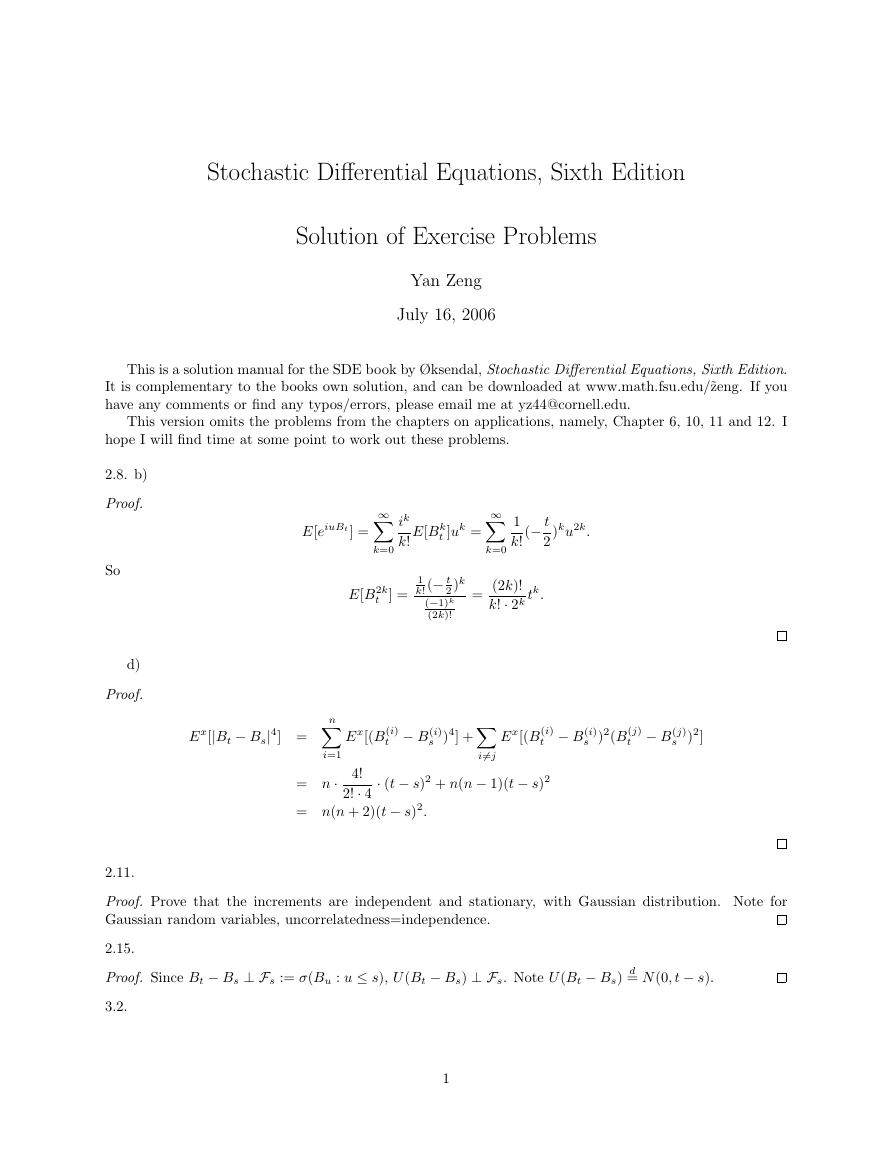
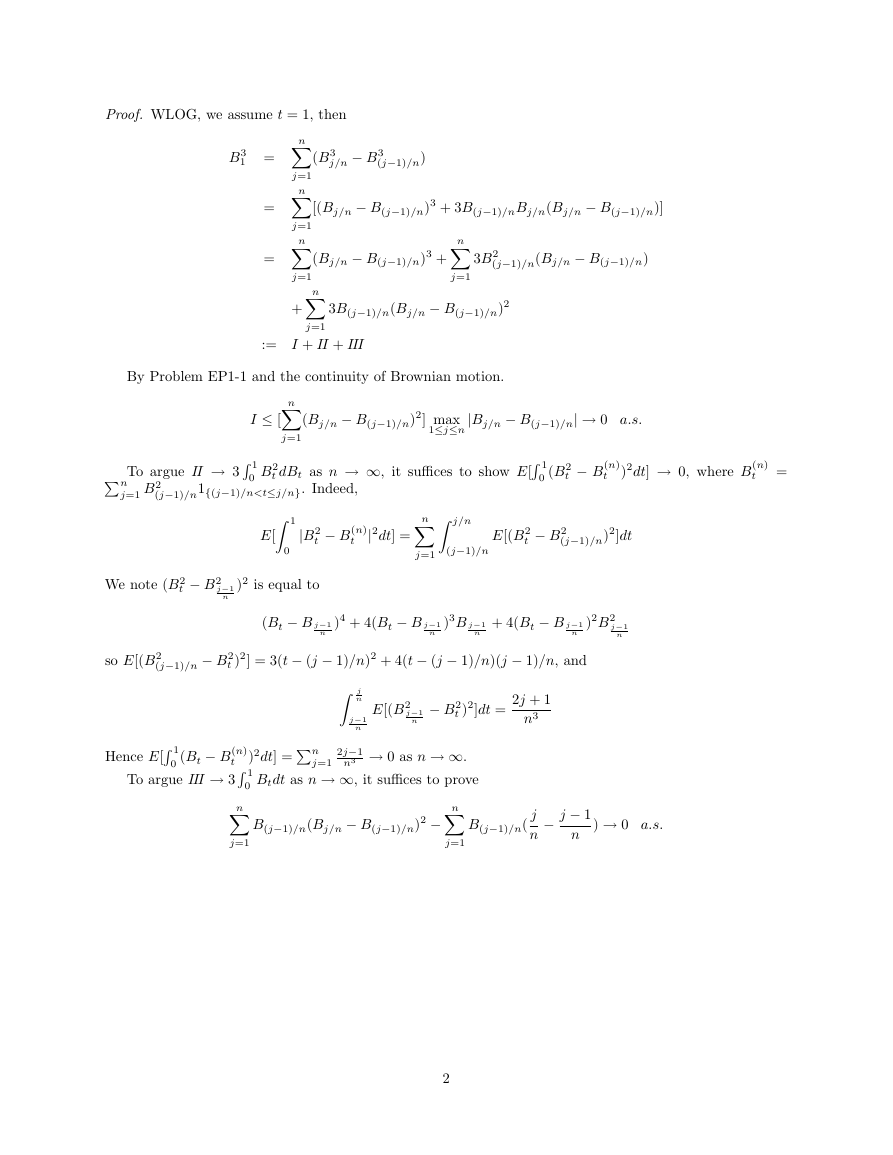
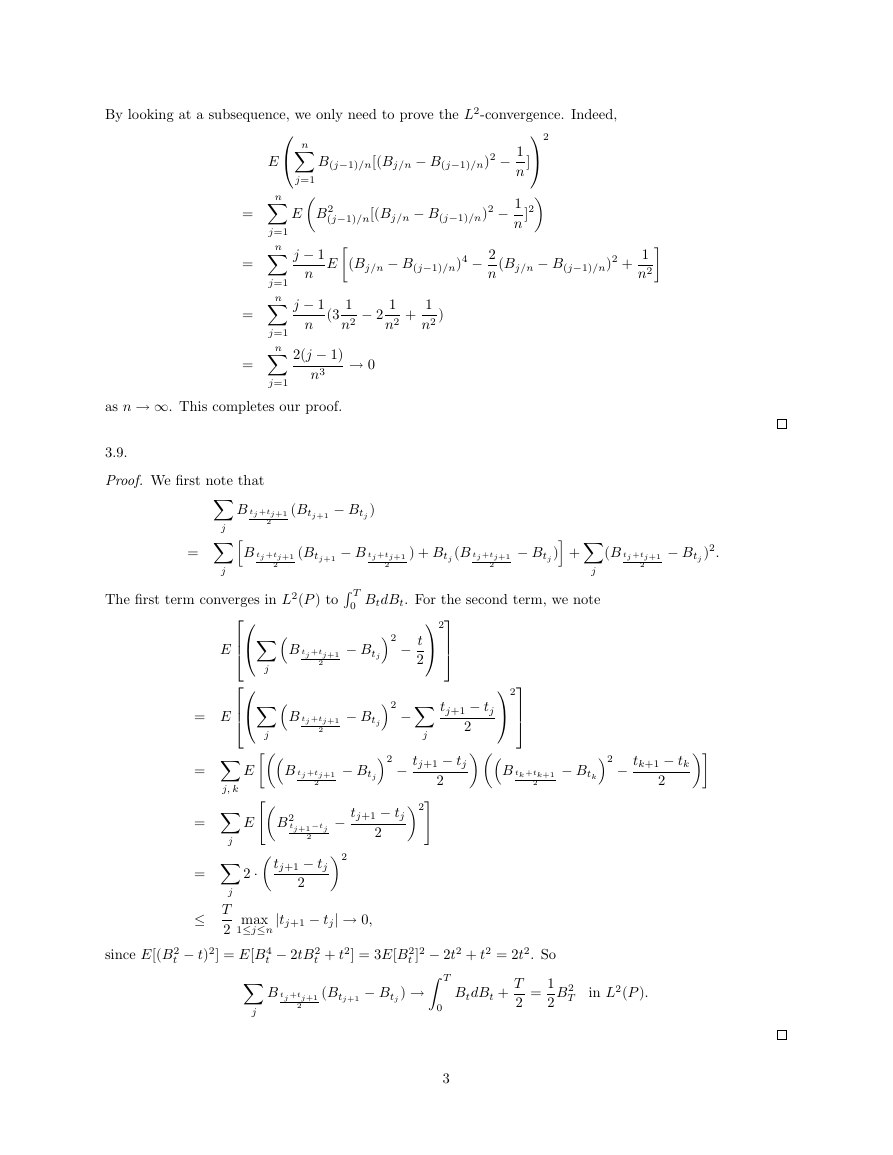
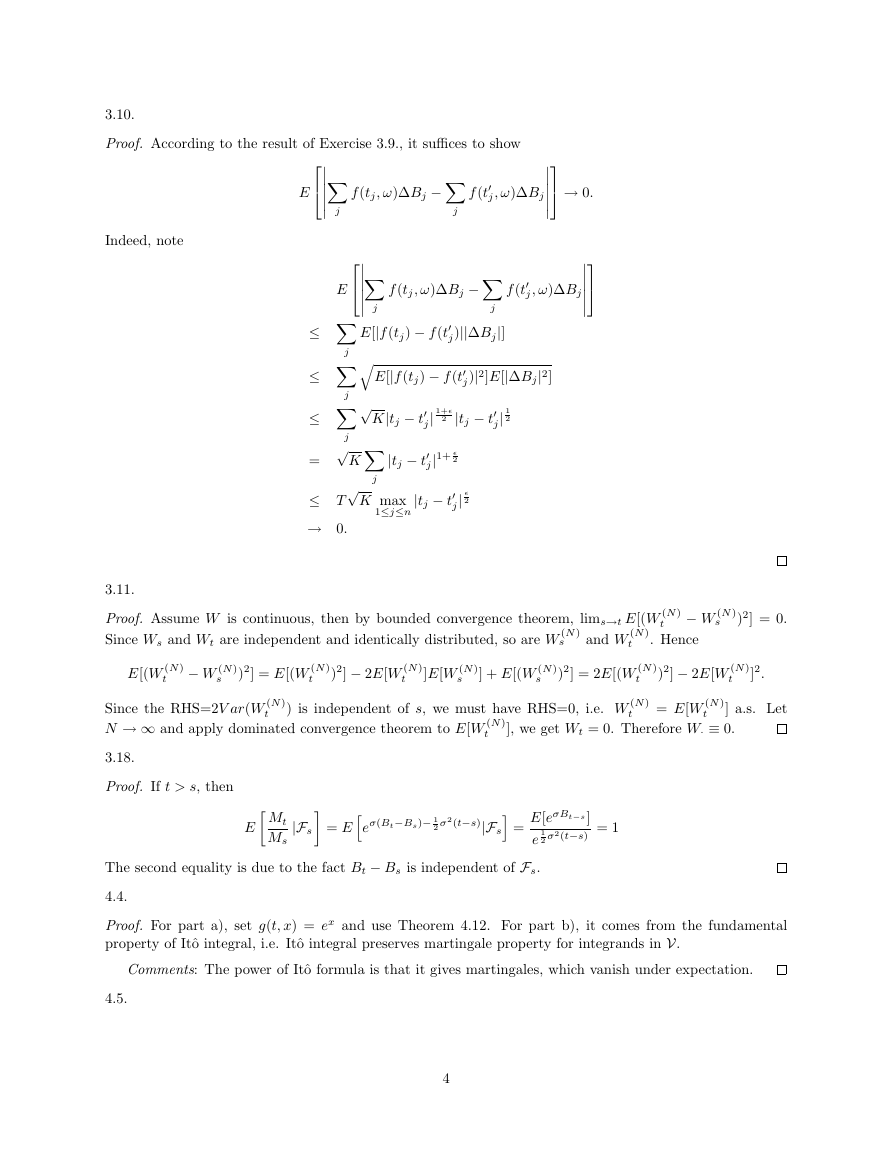

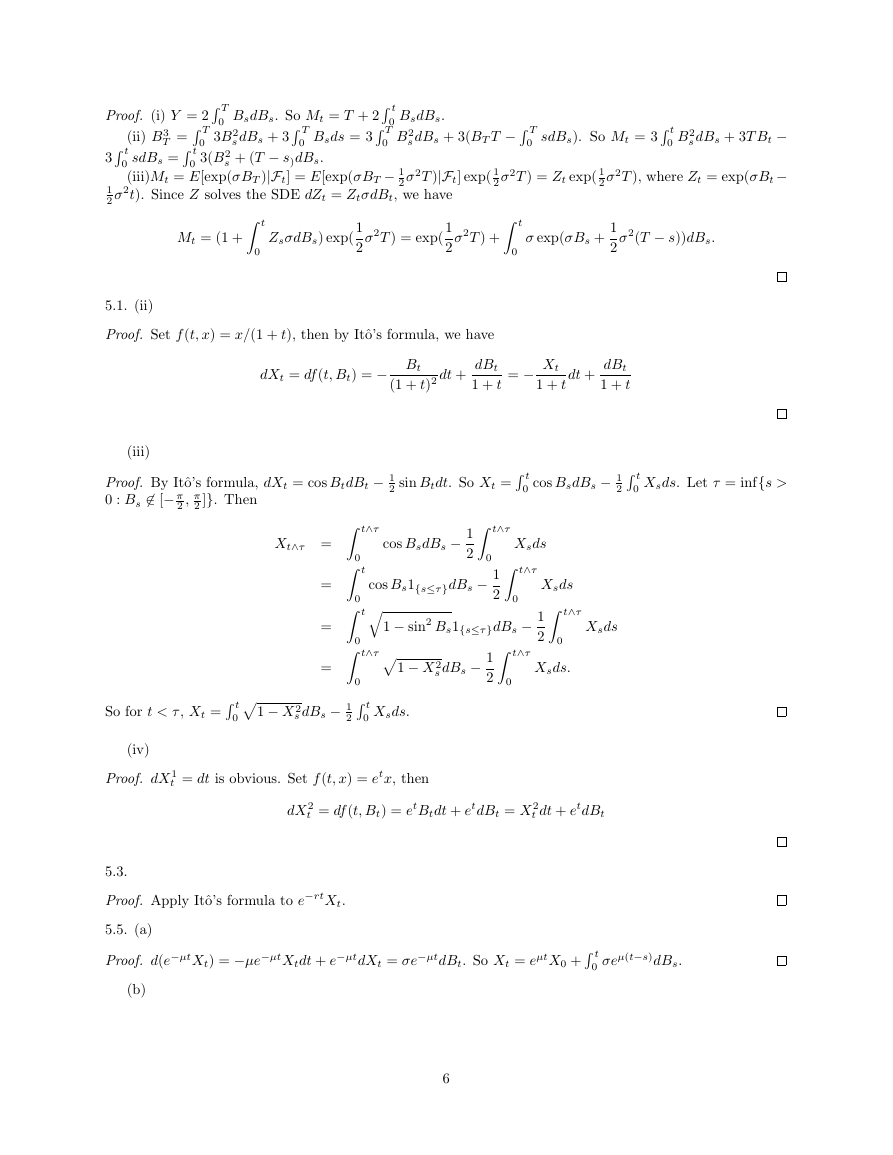
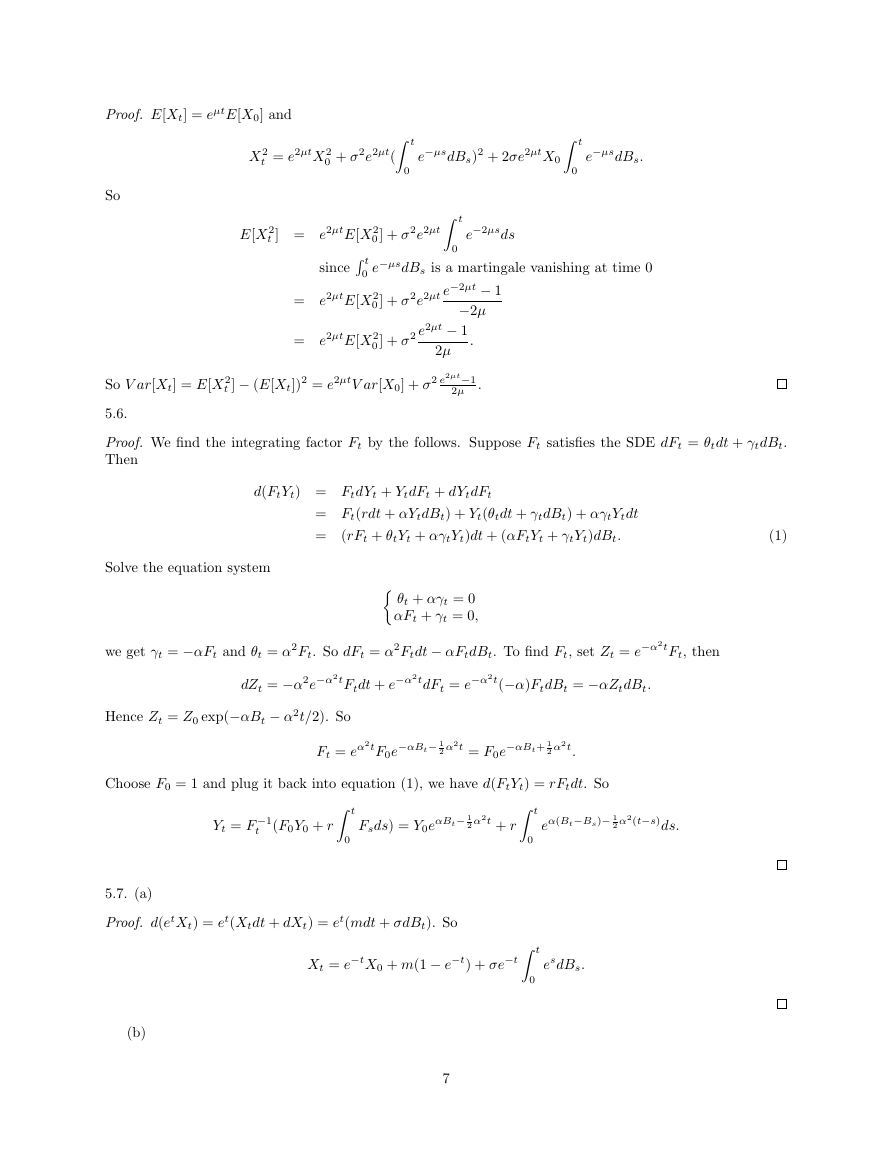
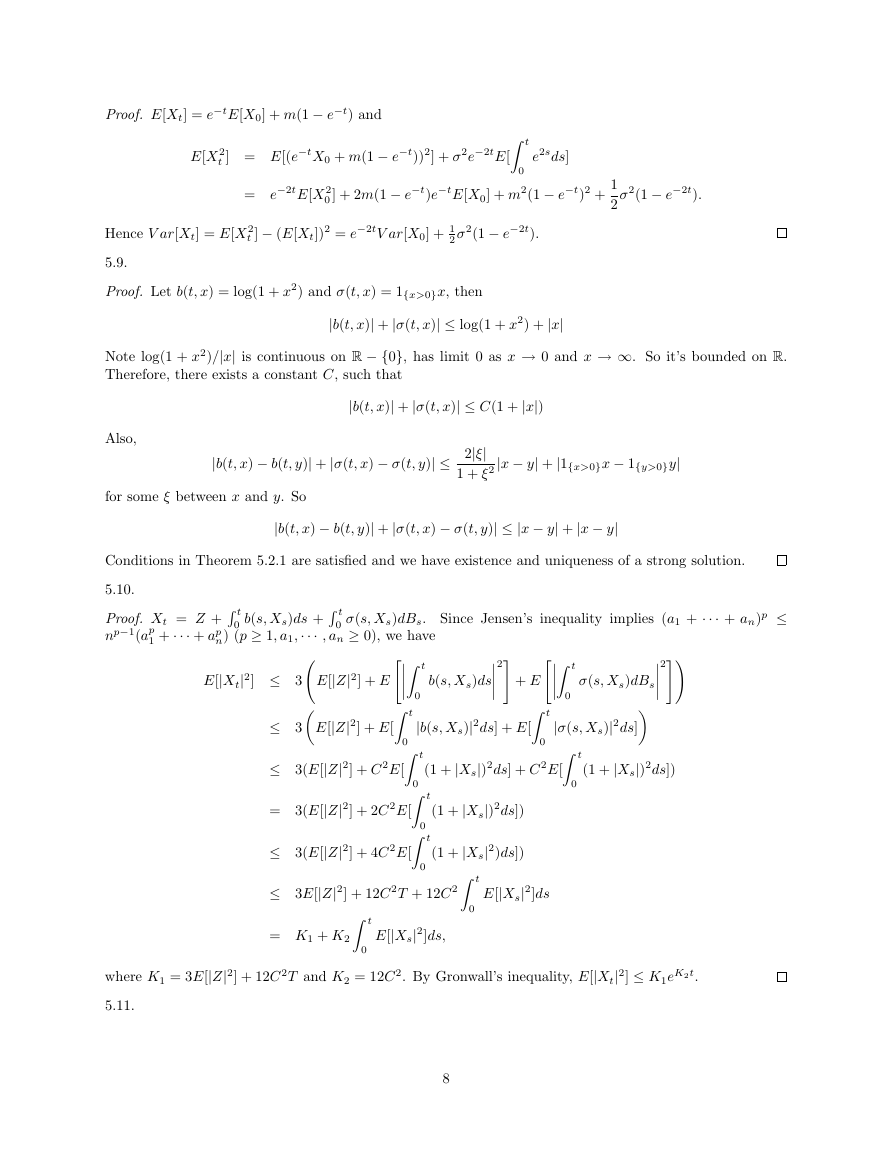








 2023年江西萍乡中考道德与法治真题及答案.doc
2023年江西萍乡中考道德与法治真题及答案.doc 2012年重庆南川中考生物真题及答案.doc
2012年重庆南川中考生物真题及答案.doc 2013年江西师范大学地理学综合及文艺理论基础考研真题.doc
2013年江西师范大学地理学综合及文艺理论基础考研真题.doc 2020年四川甘孜小升初语文真题及答案I卷.doc
2020年四川甘孜小升初语文真题及答案I卷.doc 2020年注册岩土工程师专业基础考试真题及答案.doc
2020年注册岩土工程师专业基础考试真题及答案.doc 2023-2024学年福建省厦门市九年级上学期数学月考试题及答案.doc
2023-2024学年福建省厦门市九年级上学期数学月考试题及答案.doc 2021-2022学年辽宁省沈阳市大东区九年级上学期语文期末试题及答案.doc
2021-2022学年辽宁省沈阳市大东区九年级上学期语文期末试题及答案.doc 2022-2023学年北京东城区初三第一学期物理期末试卷及答案.doc
2022-2023学年北京东城区初三第一学期物理期末试卷及答案.doc 2018上半年江西教师资格初中地理学科知识与教学能力真题及答案.doc
2018上半年江西教师资格初中地理学科知识与教学能力真题及答案.doc 2012年河北国家公务员申论考试真题及答案-省级.doc
2012年河北国家公务员申论考试真题及答案-省级.doc 2020-2021学年江苏省扬州市江都区邵樊片九年级上学期数学第一次质量检测试题及答案.doc
2020-2021学年江苏省扬州市江都区邵樊片九年级上学期数学第一次质量检测试题及答案.doc 2022下半年黑龙江教师资格证中学综合素质真题及答案.doc
2022下半年黑龙江教师资格证中学综合素质真题及答案.doc